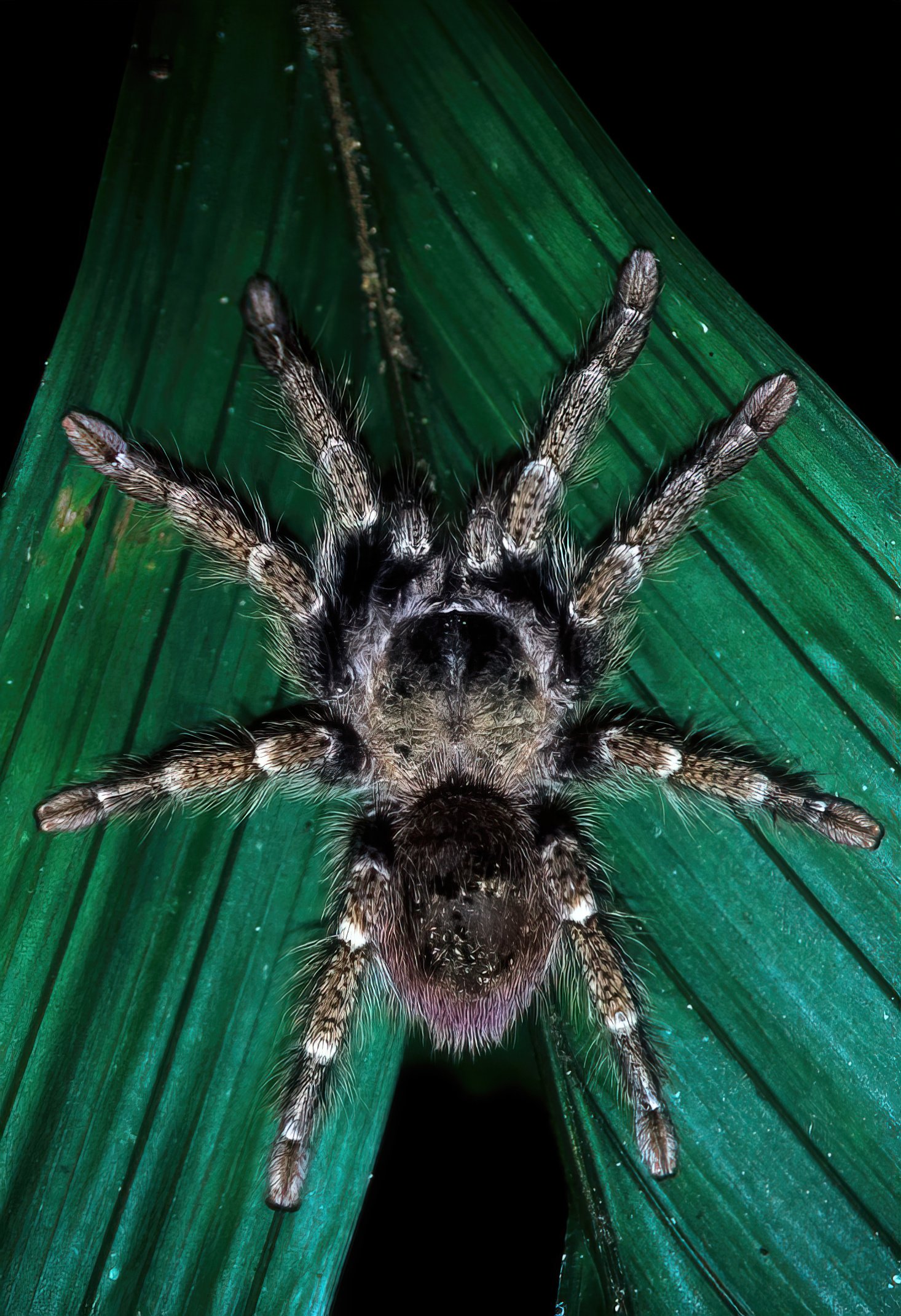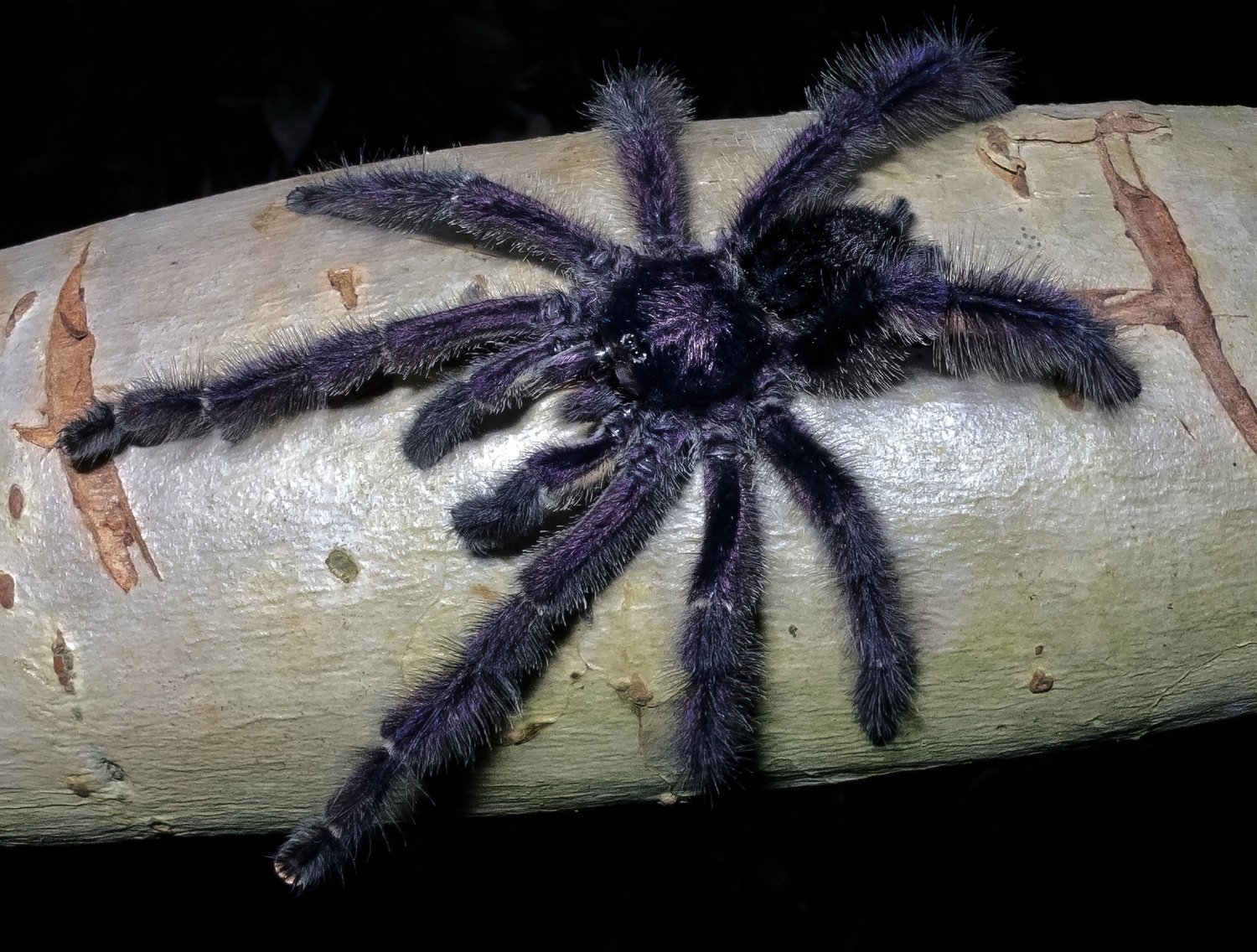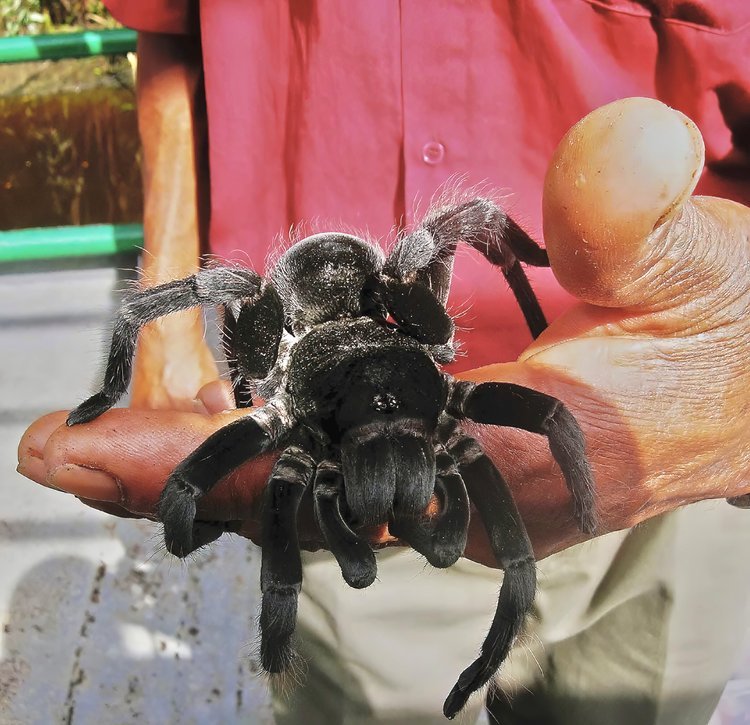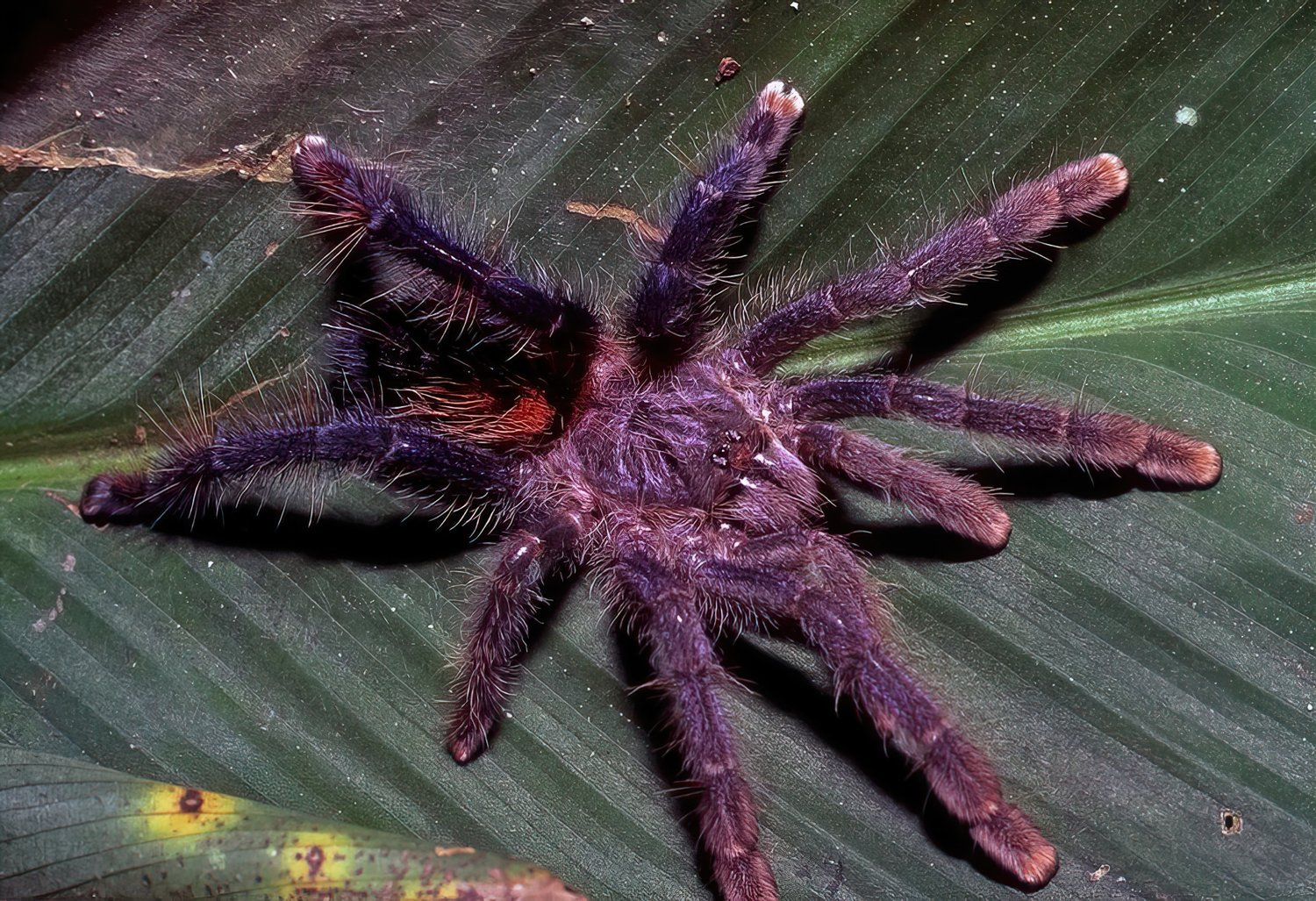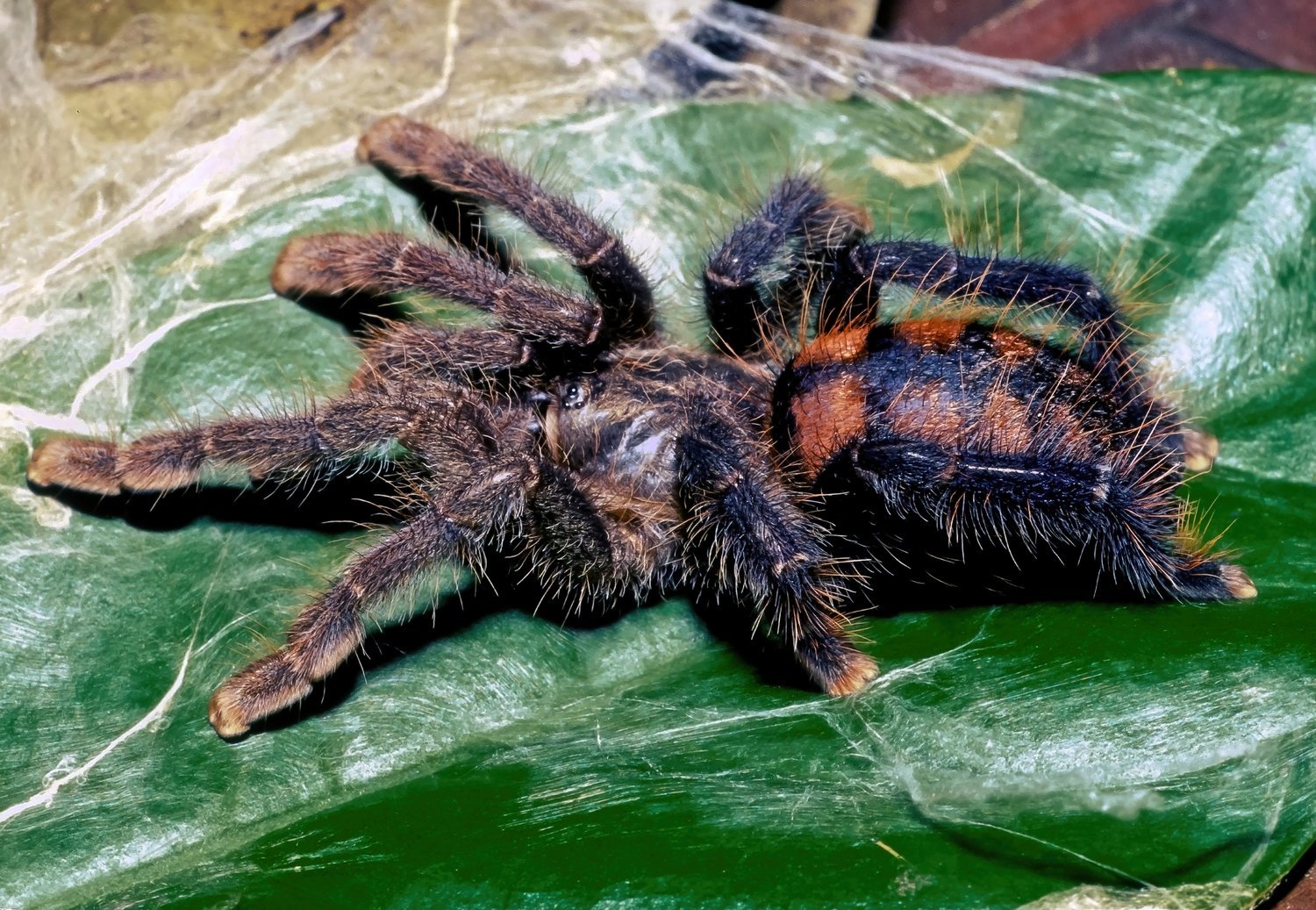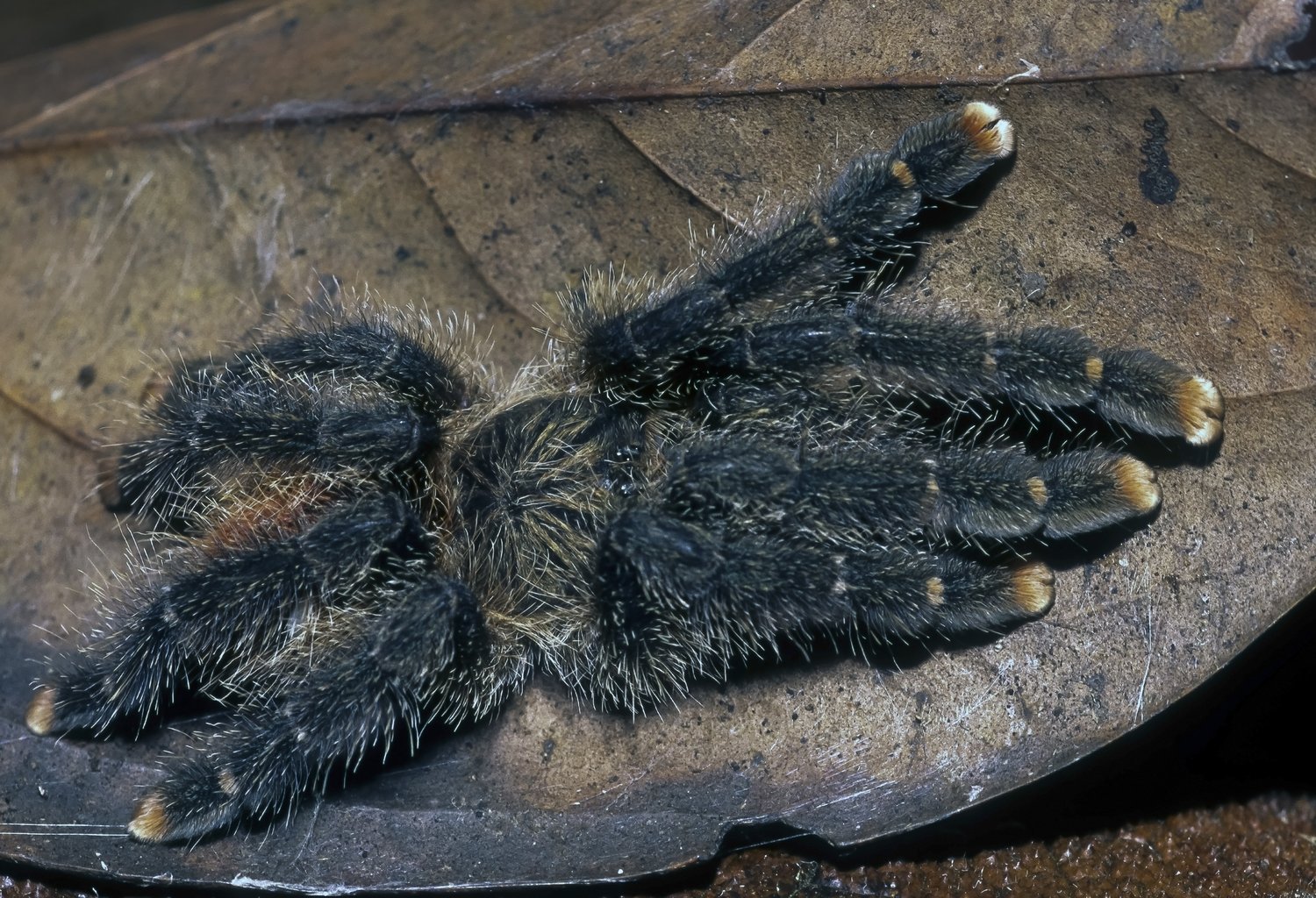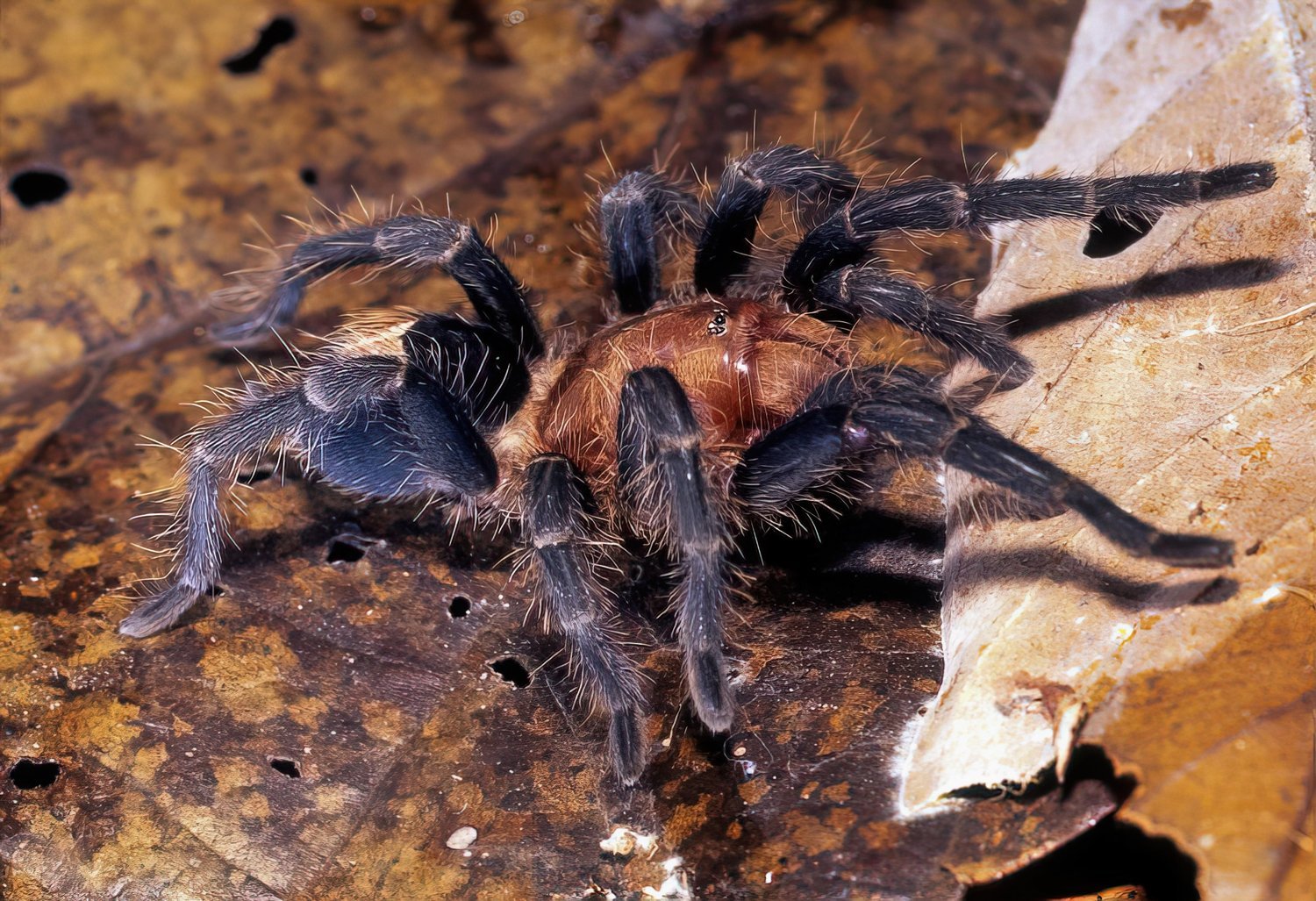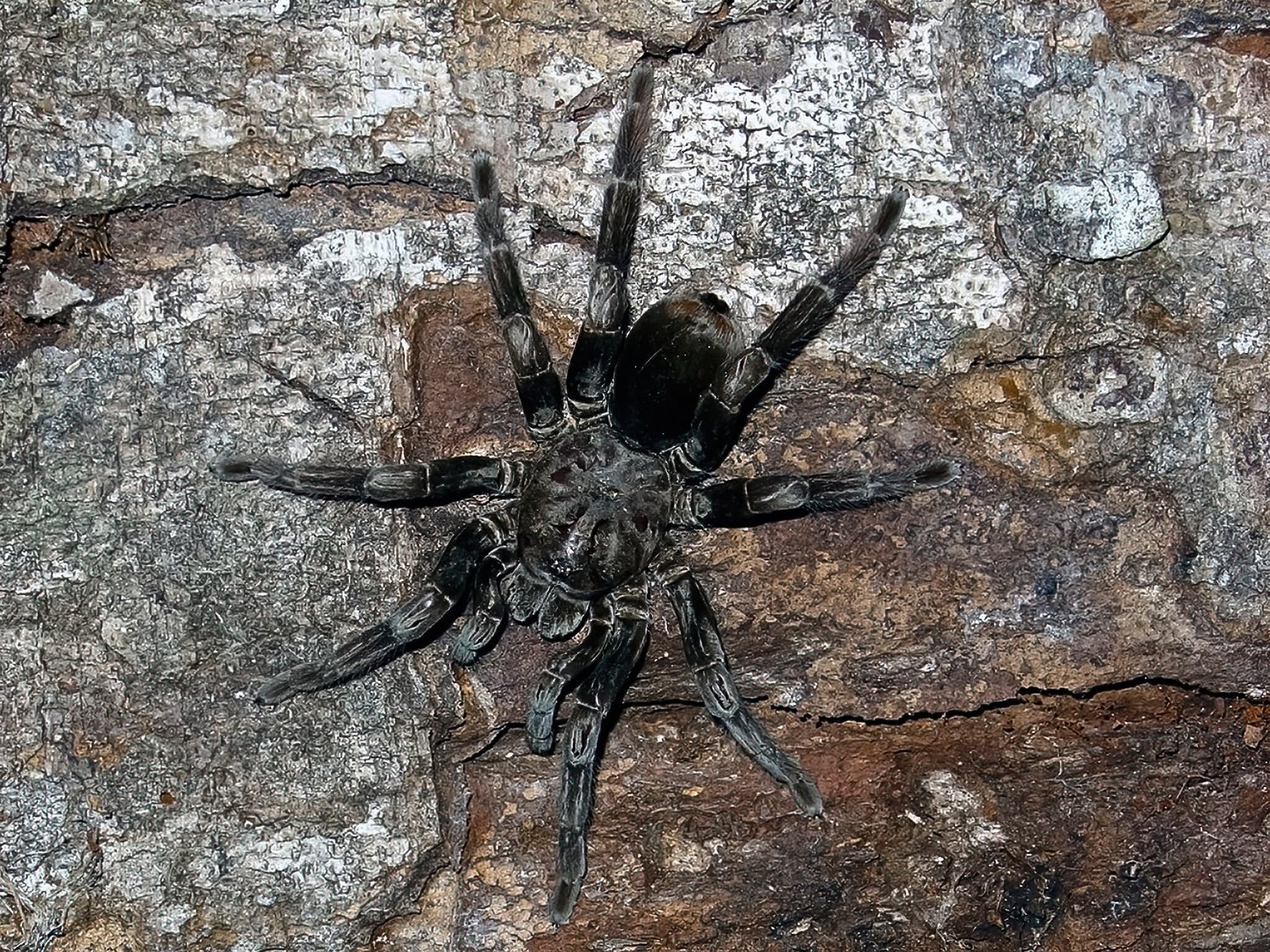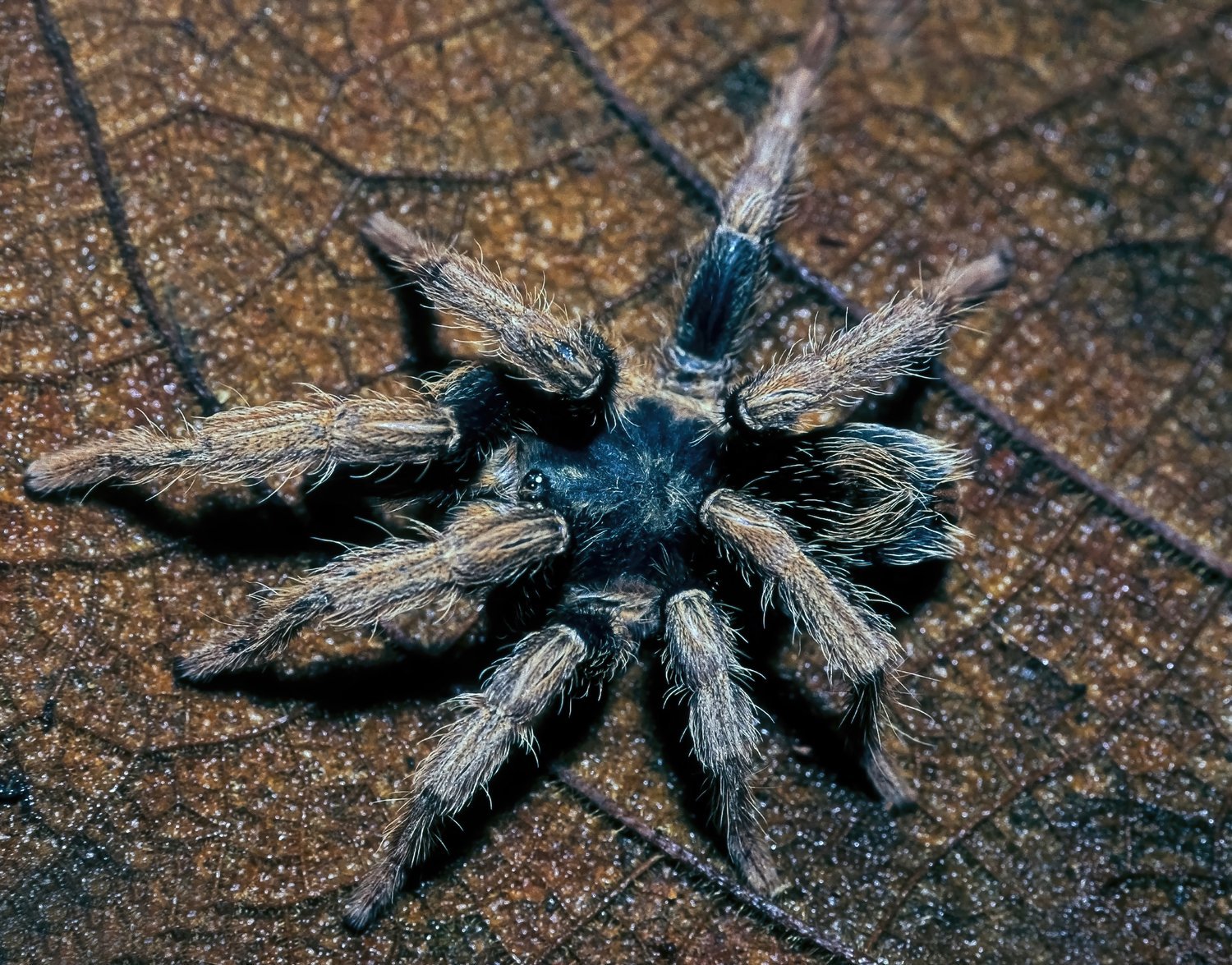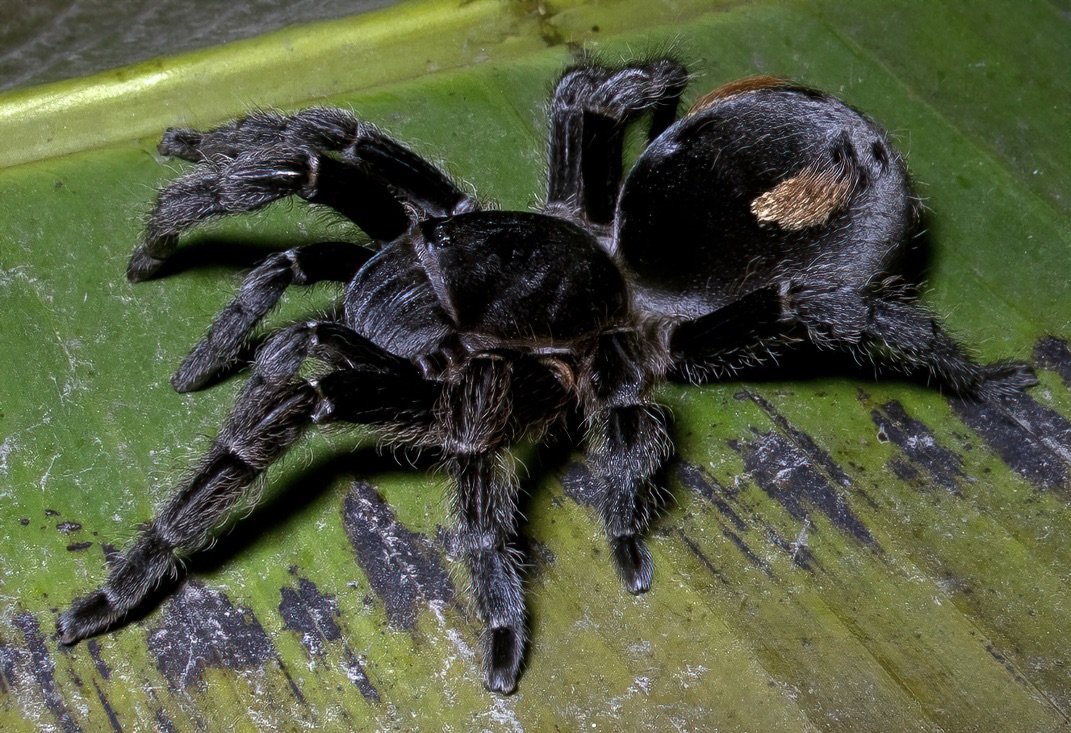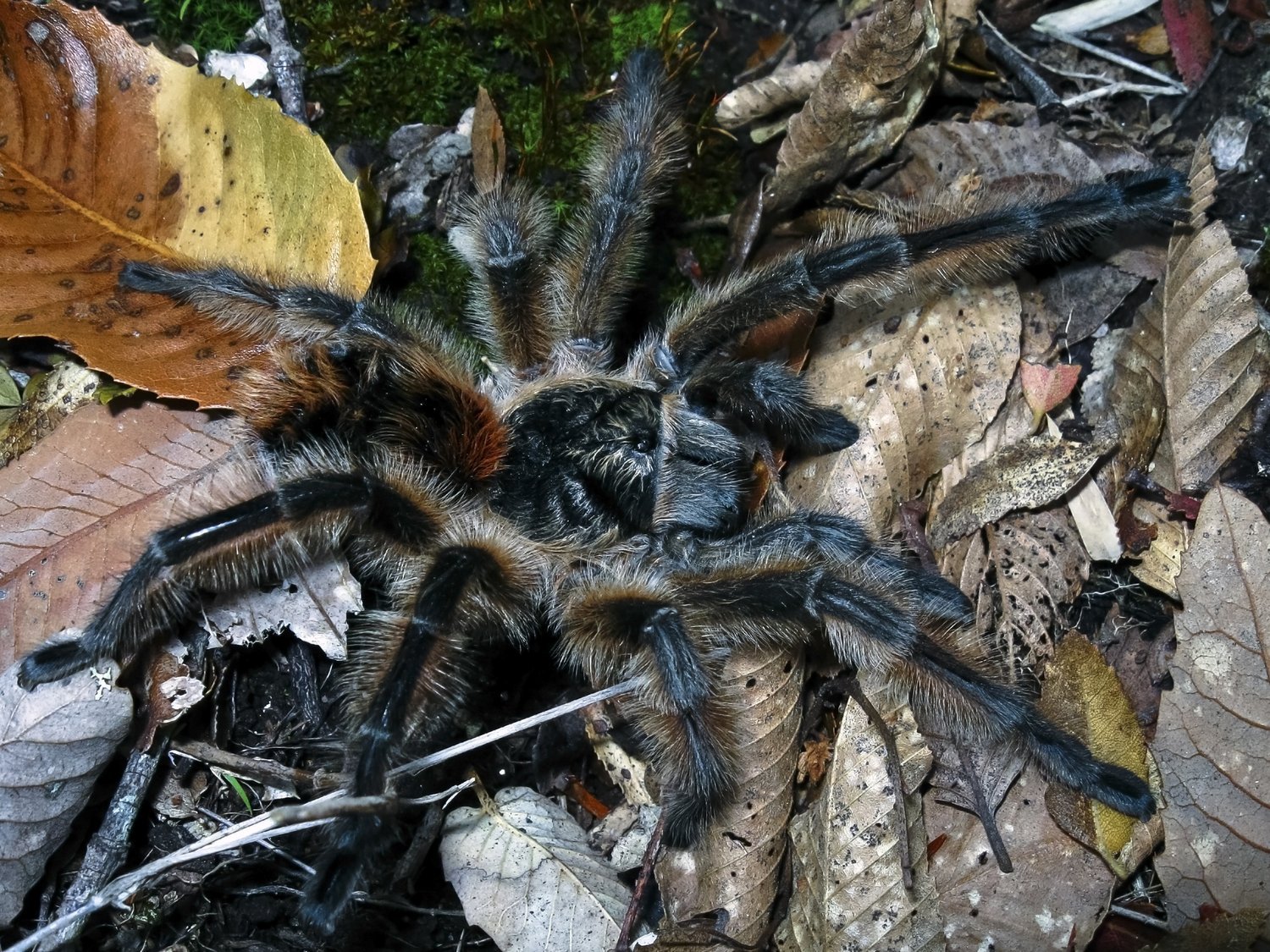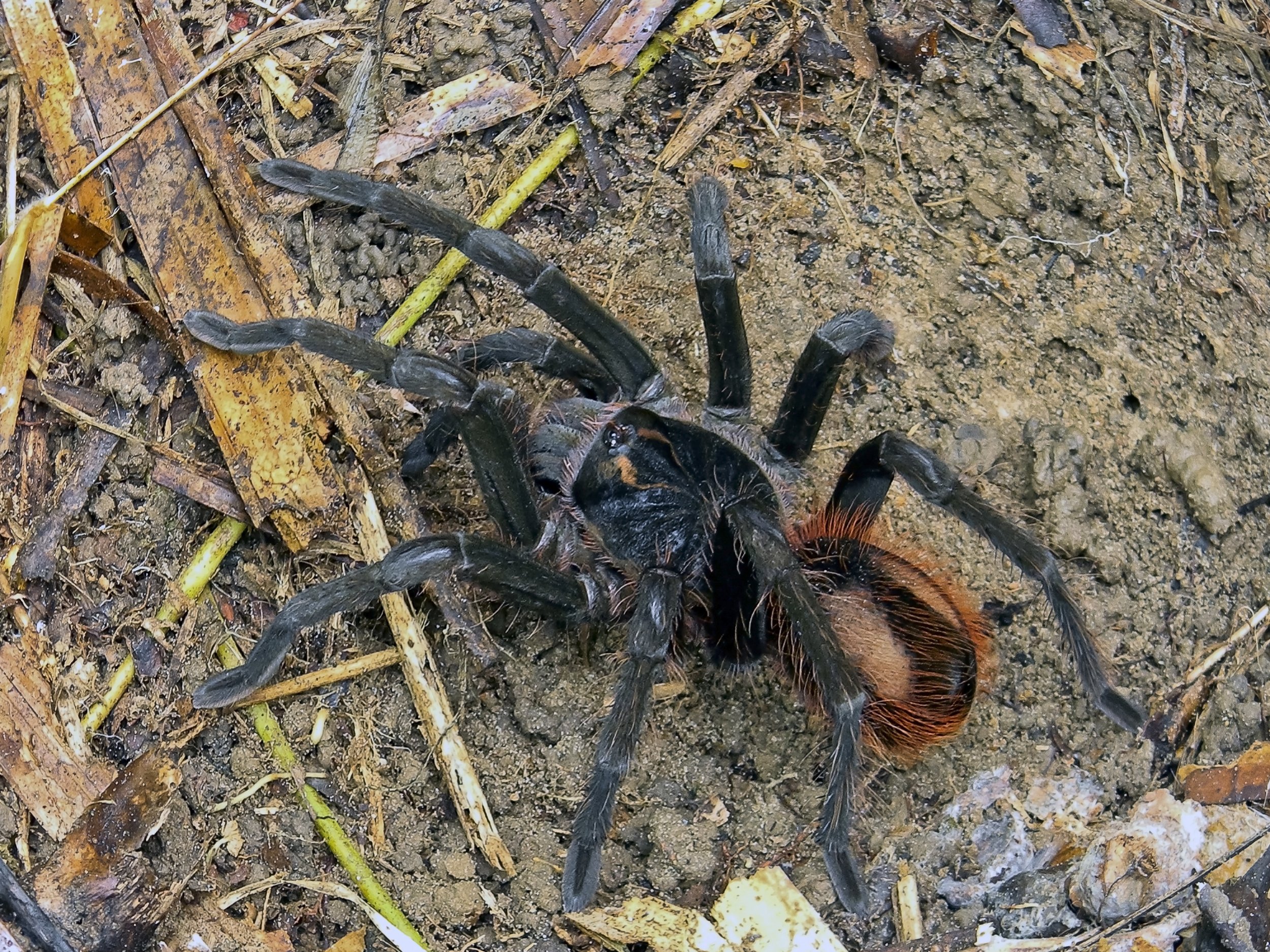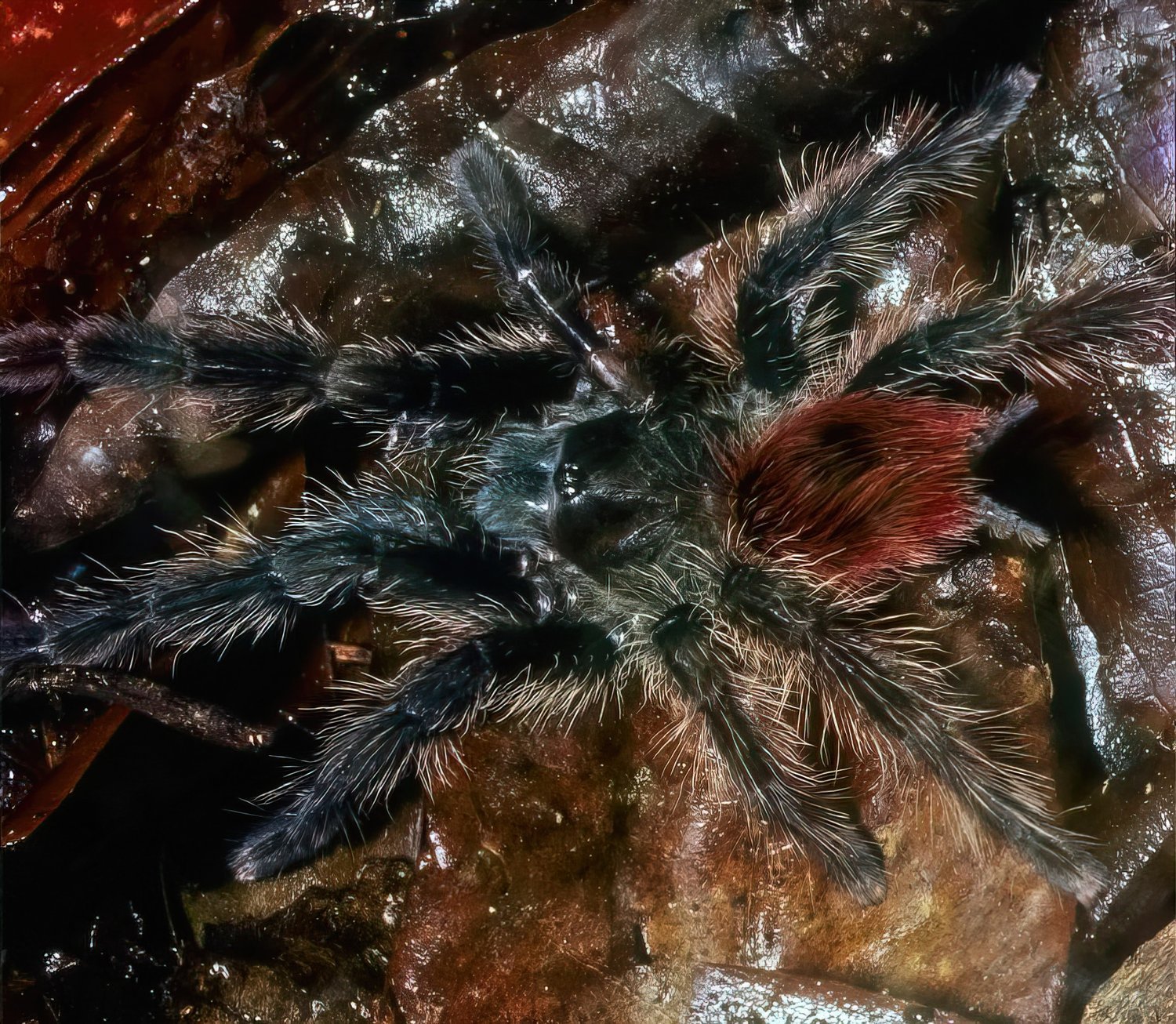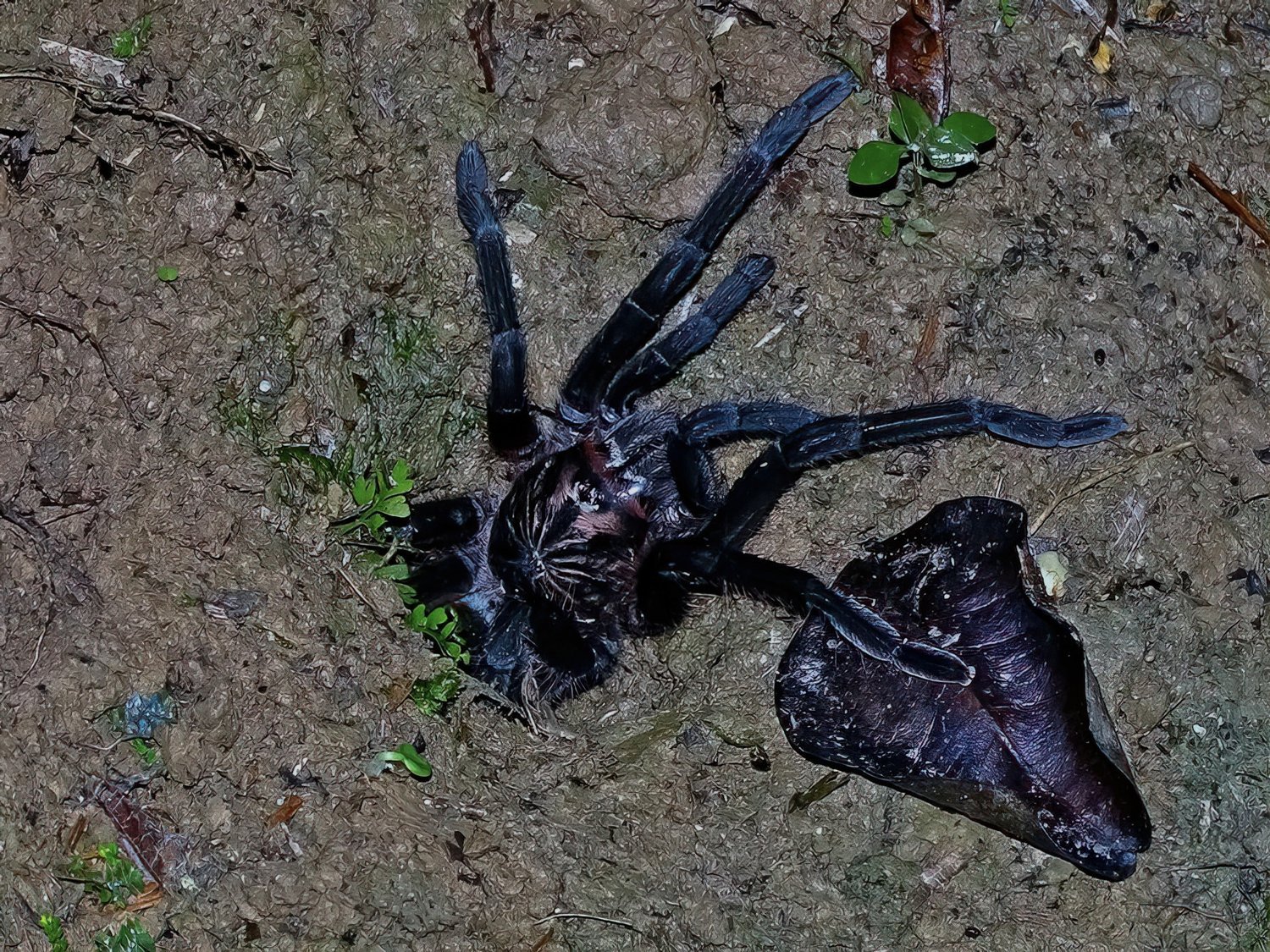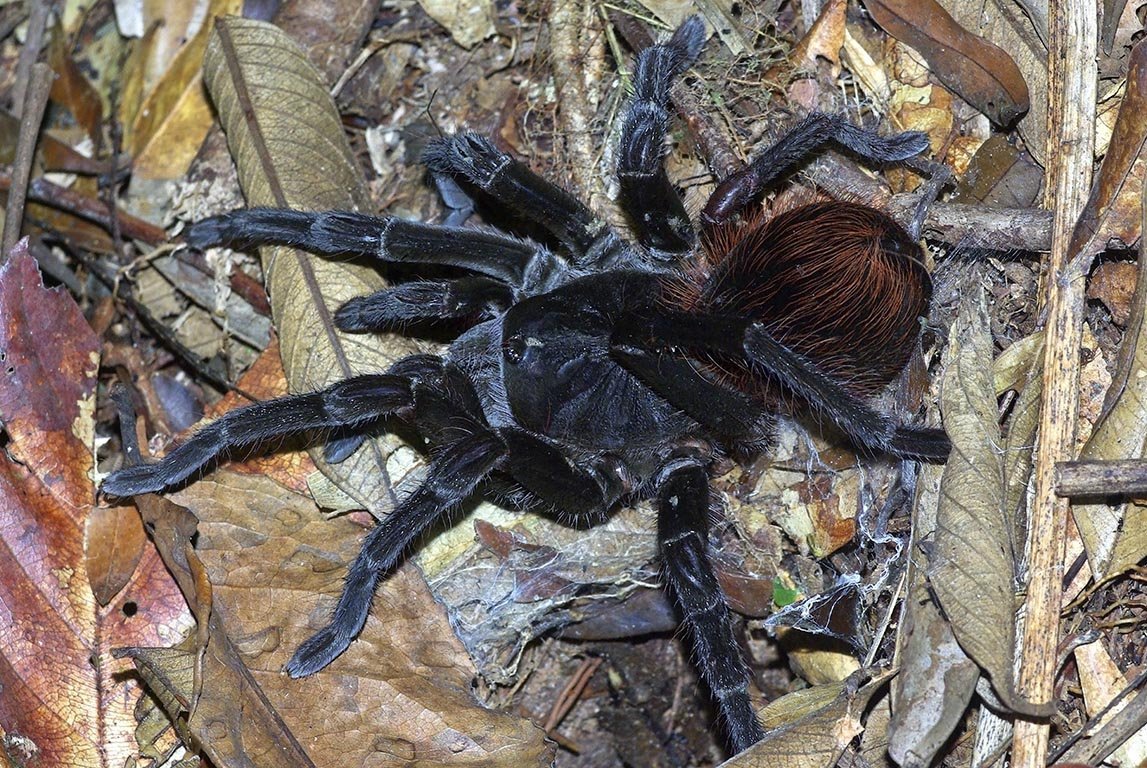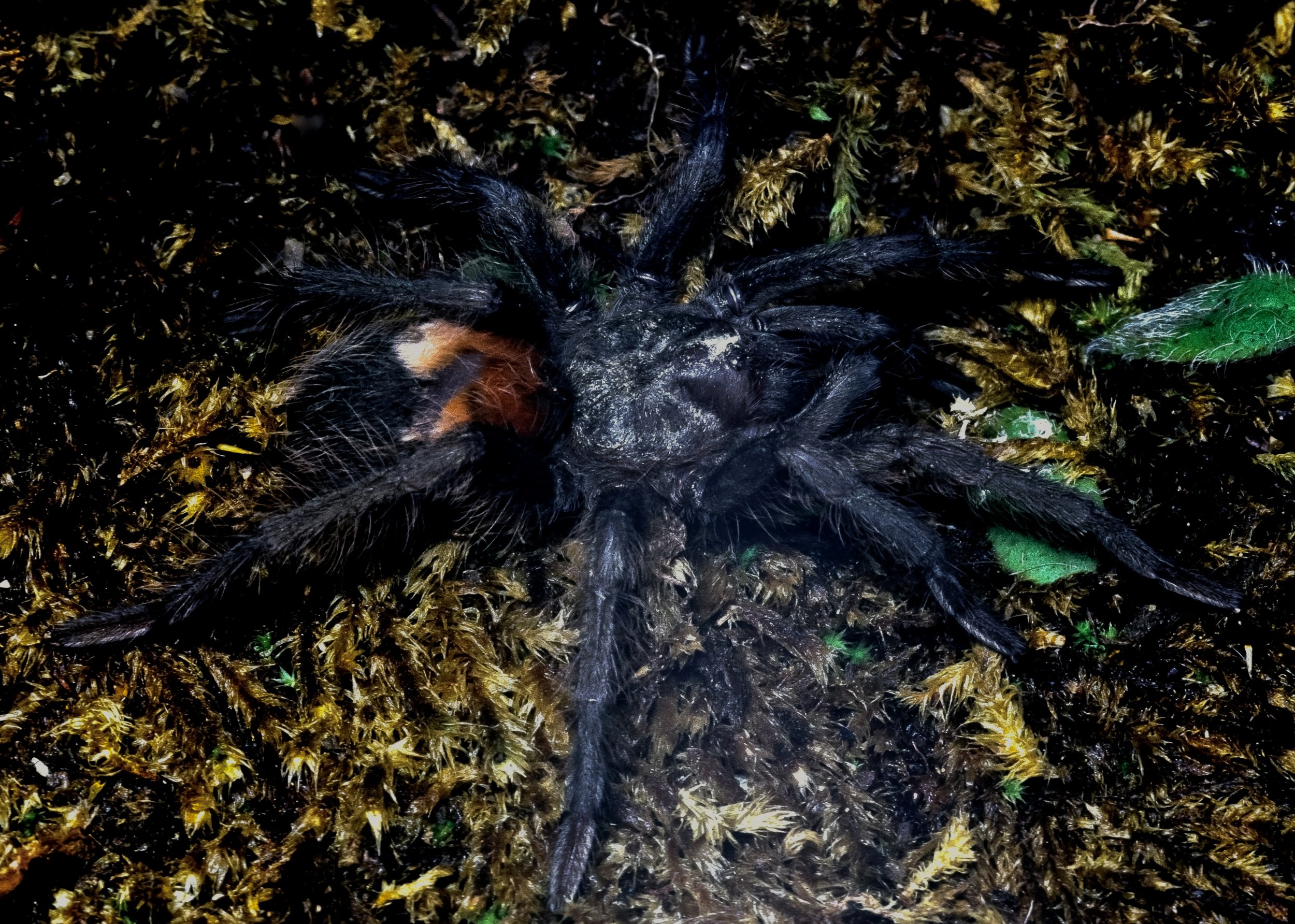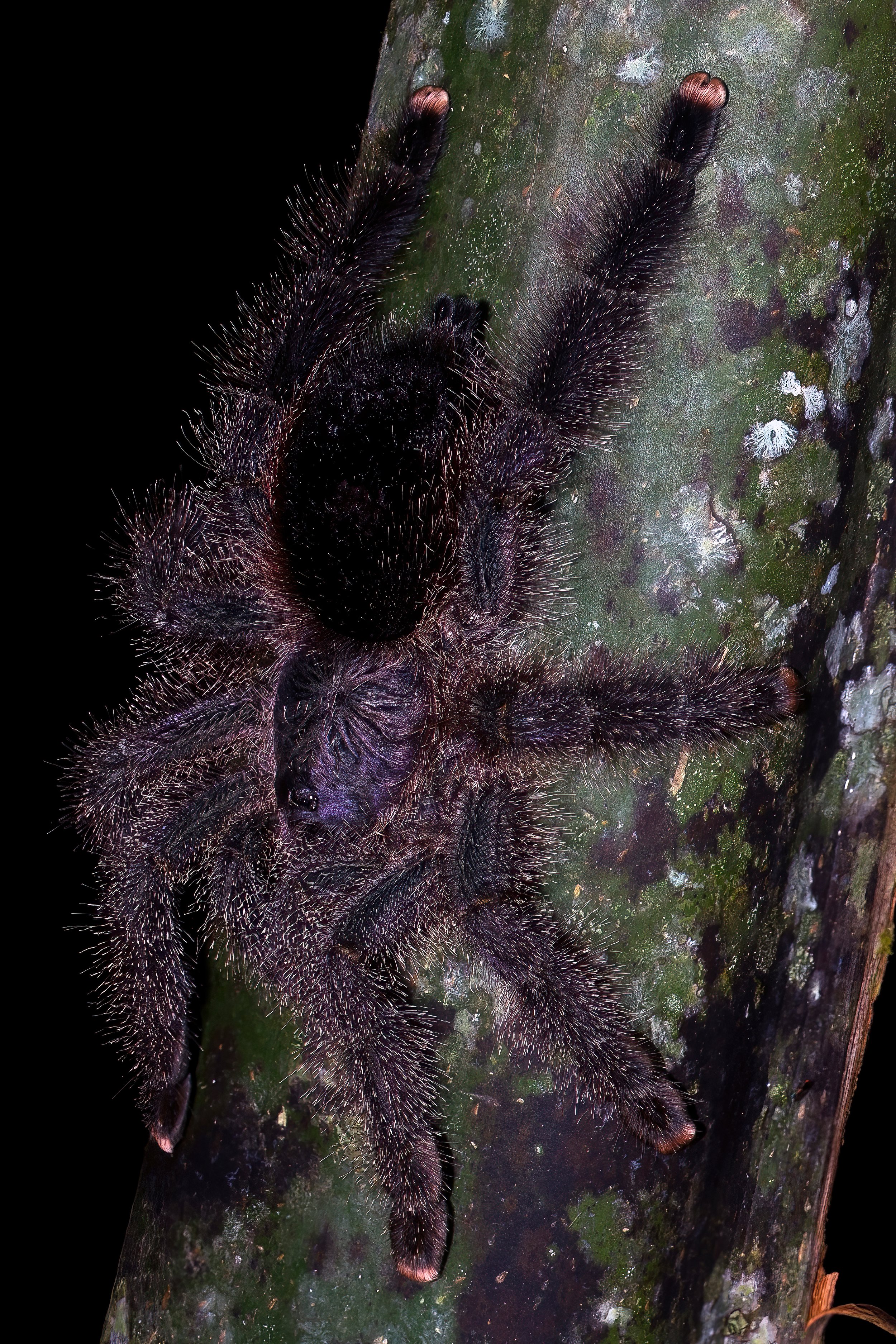And Along Came a Spider...With Some Friends and Relatives
By William W. Lamar
The author with a fearsomely hirsute but neighborly male Chilean Ocelot Tarantula (Phrixotrichus vulpinus). Image: ©Danté Fenolio 2022.
(Excerpted from the forthcoming book, “Primitive at Heart”).
It’s looking like my stroll through all the world’s vermin will require more than one story, so I’ll chip away at that herculean task with a tale about pesky arachnids, myriapods and gigantic ants. Just like all the other critters, I actually like—or at least grudgingly respect—most of these animals, so I’ll try to give you a balanced, unbiased perspective on each of them.
Herewith some of my experiences with what many might consider the creepiest of the crawlies:
Tarantulas, scorpions, centipedes, and gigantic stinging ants.
Fast and nasty-tempered, an unidentified female theraphosid from a remote region on the Brazilian border near the Río Ucayali, Loreto Province, Peru. Image: ©William Lamar 2022.
Let’s start with “tarantulas”. I use quotes because outside of science (where the name only applies to members of the family Theraphosidae), this is pretty much a catch-all term for any big hairy spider. Of course, to most everyone all spiders are big and hairy. Back in medieval times, over in the region of Pulia, in the Taranto Province of southern Italy, locals used the name “tarantula” for two kinds of spiders, one sizable, imposing and basically harmless; the other deadly but dinky and unimpressive. The popular cure for tarantism—effects produced by the bite of the smaller spider—was the decidedly un-Christian practice of having a holistic healer involving you in a “tarantella”; a wild, gyrating, sweaty dance set to lively music. The fact that an alleged tarantula bite justified the only waiver obtainable for such dancing during those stern times may well have increased the incidence or claims of tarantism, and who knows... perhaps all the gyrating somehow eased the effects of the venom. Early migrants to North America from Europe saw similar spiders and silk-lined burrows there; thus, the vernacular name “tarantula” was transplanted.
The big hairy spiders have gotten a largely undeserved bad rap for eons, much of it thanks to the way they are portrayed by the media. The movie Lord of the Rings featured a giant stinging spider. What to say? Spiders do not sting. I mean, seriously, how many people do you know who have suffered in any way (aside from self-inflicted screamies) from a tarantula? Image is everything. Hummingbirds are tiny and often beautiful, yet they are entirely undeserving of the endearing reputation they enjoy. They are tough, aggressive birds that spend much of their lives fighting. If they reached a substantial size, lord only knows what sort of trouble they’d get into. Perhaps the greatest beneficiary of favorable PR is the world’s most murderous mammal: The meerkat (Suricata suricatta). Consider the lowly hermit crab (Panguroidea). Since childhood we’ve been conditioned to see these bizarre crustaceans as cute and amusing, this being largely because pleasant travelogue music and perky commentary play whenever scenes of the little buggers ambling across the beach are broadcast on TV.
Change the channel to a show with a tarantula and it will likely be introduced via a sinuous dagger slashing silently into a canvas tent followed by a sinister looking hand that plops the spider onto the leg of the slumbering star of the program. Cue creepy music as the furry demon slowly walks up the fellow’s pants leg, and every wide-eyed child watching acquires an indelibly negative impression of spiders. Kids are too naïve and inexperienced to figure out that they use the big spiders in films precisely because they are easy going, let alone question how one came to be in the hand that deposited it. And who stops to stare hard at a hermit crab, whose ghastly looks (once you mentally get past the cute syndrome; they’re not actually ferocious) make tarantulas seem benign?
Still, the spider world does boast a few legitimate progenitors of arachnophobia, even if most folks have never seen them. Medically important ones such as black widows (Latrodectus species) and recluse spiders (Loxosceles species) tend to be small and rather insignificant looking, despite packing a witches’ brew of powerful toxins. Some tarantulas from Southeast Asia such as a Malaysian species the Chinese migrant laborers referred to as “Tee Foo” (= earth tiger; the name stuck) are vigorous defenders of their turf; they clear a substantial radius around their burrow and rush forth to engage any interlopers.
And then there are some ill-mannered and genuinely venomous African varieties.
My first experience with a big spider one might consider truculent and fractious came when I worked for an animal dealer who received a shipment from Africa that included a creature currently known as the King Baboon Spider (Pelinobius muticus). This thing was so big it made me wonder how much it might weigh. It likely spanned a dinner plate, and each leg was two or three times the bulk of any tarantula leg I have ever seen, and I’ve seen big ones. Rather than being furry, it was covered with something like rusty velveteen, a veritable greeting card from Satan. Roused from its burrow, it would burst out and rear up to expose the gigantic, gleaming black chelicerae (think: jaws or fangs).
As if that were insufficient, it also stridulated, creating a creepy noise by chafing its front legs together.
Tarantulas range from dime- to platter-sized; from unicolored to boldly patterned; from short-haired to shaggy; from cave and tunnel-dwellers to tree specialists. Many are even iridescent blue or violet. A few have horns on their carapaces. They are astonishing athletes; some can run fast or leap high; some can even walk on water by taking advantage of the surface tension. I’ve watched big ones carefully make their way up a pane of glass. Adept at sensing and capturing their prey, which usually consists of bugs, some species occasionally grab a bat, a bird, or a small mammal and this inevitably garners all manner of comments. So-called bird-eating spiders, a term now applied to a broad array of New World species, are presumed to habitually gobble up large prey items. Aside from the occasional frog or gecko, however, most of these hairy spiders get along just fine on a diet of arthropods; an occasional tiny mammal or bird being the exception, not the rule. That hasn’t stopped the dramatic name from metastasizing to include many kinds of tarantulas. I once watched an arboreal tarantula casually snare two flying moths at the same time; it was a feat that would have made baseball star Willie Mays envious. Their furriness likely provides some tactile sensory info, much like curb detectors used to do for cars; but it is simply another means of defense. Each shaft, when examined microscopically, looks like barbwire from hell. When threatened, a spider will use its legs to brush off a quantity, sending it airborne and sometimes into the eyes, nostrils and mouths of any inquisitive mammalian predator or human collector.
King Baboon Spider (Pelinobius muticus). Image: Creative Commons.
All in all, it was not what one might term a welcoming sight. In fact, it was the arachnid version of Psycho. And the thing could dispatch a young rat or a mouse in an instant, literally staving in the skull with the power of its bite, not to mention liquefying their internal organs with venom. Of course, never having seen a spider dispatch a mammal, the staff delighted in these gruesome feeding exhibitions. But the real fun came whenever it was time to clean the cage. After some hair-raising trial and error, I adopted a method using a new, furnished terrarium that was placed alongside the occupied one. A minnow dip-net was inserted into the spider’s cage whereupon it immediately swarmed, stridulating and fanging its way upward toward my hand. The handle was just long enough so I had barely enough time to lift the thing and drop it—and the spider–into the new cage . . .WHEW!! I felt like I had dealt with the Great White Shark of hairy spiders each time I went to remove the tattered net from the clean cage.
Note: Bites from adult King Baboon Spiders, while not lethal, are excruciatingly painful on many levels from accounts of the unlucky folks who have gotten chomped by one. Other African Baboon Spiders have even more potent venoms.
A Purple People Eater? Female Amazonius elenae ablaze in violet iridescence at Quistococha, Loreto Province, Peru. Image: ©William W. Lamar 2022.
“Tarantulas range from dime- to platter-sized; from unicolored to boldly patterned; from short-haired to shaggy; from cave and tunnel-dwellers to tree specialists. ”
One of the Brazilian Giant Tarantulas, Nhandu cerradensis. Image: ©William W. Lamar 2022.
Egads! Arachnid mace!
Peruvian Pink-toe Tarantula (Avicularia cf. juruensis). Image: ©William W. Lamar 2022.
I’ve run across many kinds and sizes of tarantulas over the years. They’ve turned up in fields, crossing roads, in deserts, rock piles, up trees, high in the mountains, in mist nets strung to capture birds, deep in the rainforest, and even in my bed. My tendency to play with them used to irritate some of my herpetological field companions but it led to friendship with a crusty Canadian who is one of the world’s top authorities on the big hairy spiders. He astutely observed that his quest for them turned up a lot of reptiles, whereas my quest for reptiles turned up a lot of tarantulas. Teaming up in the field on more than one occasion in more than one country has been a lot of fun, not to mention educational, at least for me. We worked together when National Geographic magazine decided to run an article on the big spiders, and I woke up the very first morning to find a fat tarantula slowly crawling up my leg (without some evil-doer’s hand having put it there).
What are the odds of that happening?
We were based at an old lodge on an Amazon tributary in Peru and the place was crawling with weirdies. I slowly got out of bed and made my way, tarantula and all, to my friend’s room. He rolled over, glanced at my leg, smiled and said it was a species of spider not yet recorded for the region. It marked an auspicious start to the spider expedition. Never, before or since, have I had the pleasure of being awakened by a tarantula on my leg.
Male Purple Pink-toe Tarantula (Avicularia purpurea) doing its best to look like a Halloween rubber spider in Amazonian Peru. Image: ©William W. Lamar 2022.
The big spiders can also be very helpful. Once I was based at a lodge on the Amazon River while making a reptile and amphibian collection for a major US museum. A group of vegans from California arrived and more or less took over the place. The food line at the evening buffet grew ever slower as each one fussed and chatted over every single dish. I was in a hurry because I needed to work in the rainforest by night in order to find specimens. One time, stalled in line again, I noticed a large bird spider attempting, with difficulty, to negotiate the palm thatch roof. It was poised high above the food and looked as though it might tumble onto the buffet table at any moment. None of the Californians had noticed so I clicked on my flashlight and held it pointed at the hairy spider. Once the secret was out, they gasped and scattered leaving me immediate access to the food.
Flame Rump Tarantula (Thrixopelma ockerti). This fellow took umbrage when I tried to pluck it from inside of a stump and I suffered a bite that went through a thumbnail as a result. Image: ©William W. Lamar 2022.
Like nearly all creatures, big spiders tend to beat a hasty retreat when confronted, and most are pretty forgiving of the bumbling humans (like me!) who like to mess with them. I once found an unusual bright red-rumped tarantula that, at the time, was new to science, so naturally I wanted to collect it (it is now known as Thrixopelma ockerti). I was on a trail in swampy Peruvian rainforest at night and the spider was inside a hollow stump. A hole in the side offered a way to reach it, so I used a clear polypropylene plastic bag as a glove, the idea being to quickly snatch the spider while reversing the bag over it as I pulled out. Now this has worked marvelously for me on other occasions, but the confines of the hole and the hollow stump slowed my movements a bit too much and the spider, with all the justification in the world, flipped over and drilled me on my greedy little hand. It felt like getting hit with a hammer, perhaps because it struck the tip of my thumb, driving a round hole right through the nail into the flesh.
OUCH! Venom effects were negligible but the pain from the physical blow was substantial.
My crowning achievement in the tarantula buffoonery category came in the Vaupés forests of Amazonian Colombia. The area had some isolated rain-filled pools where frogs congregated in massive numbers to breed. Lacking predatory fish, it was frog mecca. One night I set up a cassette recorder in order to document the call of a new species of treefrog. I eased off a steep side into the chest-deep water and parked the recorder on the bank next to me. The frogs were perched all around on emergent twigs, so I switched on the unit and stood silently in darkness waiting for the calling to commence. I whispered the time, date, and water temperature into the microphone before I began my vigil. When I finally had the desired sounds taped, I reached back without looking to turn off the cassette player and that is when I got a recording more unique than the treefrogs . . . the sound of a tarantula biting me.
A big spider had made its way onto the recorder and was resting there, evidently waiting for something to eat. I made the mistake of putting my groping hand right into the line of fire.
I wonder if it is the only audio recording ever made of a person being bitten by a tarantula (the profanity was all mine)?
Female Pamphobeteus sp.. These gigantic, black velveteen spiders can sometimes be found living in old burrows located in unused portions of Leafcutter Ant (Atta species) mounds. Image: ©William W. Lamar 2022.
Scorpion Stings
Black-edged Bark Scorpion (Centruroides limbatus) posed in ambush, Guanacaste Province, Costa Rica. Image: ©William Lamar 2022.
Costa Rican Bicolored Bark Scorpion (Centruroides bicolor - dead) that stung me very painfully during a film-shoot for Animal Planet. Image: ©William W. Lamar 2022.
As kids, my cousin and I used to make our way to the Old Mill in North Little Rock, Arkansas. We didn’t know or care at the time that it had famously appeared in the opening credits of the movie “Gone with the Wind,” nor were we interested in the outstanding faux bois (false wood) sculptures of famed Mexican artist Dionicio Rodríguez that grace the mill’s main building and grounds. There is a pond there and back then the place was crawling with creatures of all types, so it was unspeakably cool in our opinion. Bats used to dwell inside the mill itself. Amphiumas (eel-like salamanders) and common snapping turtles lived in the water. Lizards scurried everywhere. And turning stones revealed a potpourri of beasties that ranged from small snakes to weird beetles. One afternoon I flipped a rock to reveal a family of striped bark scorpions (Centruroides vittatus); there were nine of them extending from adults to a tiny one no more than a quarter of an inch/6 mm long.
Ecstatic at finding my first scorpions, I panicked immediately as they began to disperse. My cousin, searching in another sector, had the jar so I had no way of catching one. Watching in frustration, I decided the sting of the littlest one couldn’t be all that bad, so I plunked a fingertip down on it, with the predictable result. The pain was instantaneous and felt like a match flame, but I persisted. I simply had to have that critter. Luckily, the soreness subsided after a short period. This encounter launched years of peeling bark from decaying trunks and flipping rocks in order to catch scorpions. I kept them in jars and fed them small insects, studying how they stalked and captured their prey. I noticed the stinger was on a terminal bulb at the tip of the tail, so I removed it and had myself a stingless scorpion, something I thought was wonderful and tempting to play practical jokes with...
Of course, when I fooled my mother with it things did not go so well for me for a few days.
I consider scorpions to be simply astonishing animals, like little extraterrestrial lobsters with stingers. That tiny one at the Old Mill was the first of innumerable scorpion stings I have suffered, always in conjunction with catching them or bothering them.
Most have come from mildly toxic species, but one slip-up was involved one that was not.
Peruvian Black Scorpion (Tityus asthenes) feeding on an immature roach. This genus contains some of the most venomous scorpions in the New World, notably the very dangerous Brazilian Yellow Scorpion, T. serrulatus. Image: ©William W. Lamar 2022.
On a muggy night at my base camp in eastern Colombia, working by the glow of a kerosene lantern, I was seated outside at a crude wooden table, writing in my field catalogue, and enjoying some Ron Viejo de Caldas, a remarkably smooth rum. Moths and assorted insects attracted to the light banged away suicidally at the lantern glass. All of a sudden, a huge scorpion, moving more like a tank, crawled up the side and onto the top of the table. It was the largest one I have ever seen in Latin America, so I decided to add it to the collection. Evidently, I was in my cups, because with nary a thought I grabbed the forceps and seized it. Unfortunately, in my carelessness I picked the critter up by the body rather than the tail tip which proved to be a tad longer than the forceps, so it promptly stung me. But unlike the little striped bark scorpion of the U.S., this was one of the medically important Peruvian Black Scorpions (Tityus asthenes and relatives) found across the Amazon basin. The sting wasn’t as painful as I expected but the side effects–numb lips, chills, stomach cramps, and tender lymph nodes–took me out of commission for an entire day. I am guessing it failed to inject me fully, since a number of Tityus species can and do kill adult humans on a regular basis, or perhaps I just got lucky.
Or maybe it was the therapeutic counter-effect of that delicious, aged rum?
Long ago, some clever person discovered that scorpions fluoresce under illumination from a black light; they show up as though spray-painted in electric, phosphorescent blue. This makes looking for them in dense rainforest a much easier task, not to mention fun. I’ve enjoyed observing scorpions over the years and find them to be, like tarantulas, basically easy going. Most often I see them in the rainforest at night perched singly, upside down, on a tree trunk waiting for something edible to stray too close. One time I encountered another Peruvian black scorpion after repeatedly jamming my foot into a sock that just didn’t feel right. Something crusty was in the toe; irritated, I turned the sock inside out, exposing a big scorpion that obviously had chosen the spot for a peaceful retreat. Either it was exceptionally tolerant or else it couldn’t swing its tail to deliver a defensive sting in close quarters. Regardless, I was grateful for its consideration and released it.
Scorpion fluorescing under ultraviolet light. Image: ©William W. Lamar 2022.
“All of a sudden, a huge scorpion, moving more like a tank, crawled up the side and onto the top of the table. It was the largest one I have ever seen in Latin America, so I decided to add it to the collection.”
Centipede Encounters
Giant Red-headed Centipede, Scolopendra heros. Image: ©W. W. Lamar 2022
During the same Arkansas visit that brought me my first scorpion sting, I had a much more unpleasant encounter that was also entirely my own doing. My cousin and I were flipping rocks and once again, for some reason, he was in possession of our only jar. I lifted a rock and lying motionless beneath it was a Giant Red-headed Centipede (Scolopendra heros). Six inches/fifteen centimeters long, glossy blue-black with yellow legs and a scarlet head, it was so magnificent I had to have it. Despite being labeled a centipede, these imposing predators are only equipped with sixty-some legs, each one as muscular as a ballerina’s. And would you really want to label a bug a sexagintipede? Every leg is tipped with a sharp claw and the first pair are modified into maxillipeds (think: fangs); these are used to both crush and envenomate prey. Scads of lurid tales surround big centipedes, usually asserting that each claw is capable of injecting dreadful venom. The legs are reported to have such strength that they leave a series of bloody tracks across a victim while sending him on his way to a staggering, horrid and agonizing death.
The distinguished arachnid biologist J.L. Cloudsley-Thompson was once moved to say,“Centipedes seem to exert a weird fascination on the morbid appetites of the hysterical and insane.”
“Despite being labeled a centipede, these imposing predators are only equipped with sixty-some legs, each one as muscular as a ballerina’s”
Giant centipede (Scolopendra sp.), Amazonian Peru. Image: ©William W. Lamar 2022.
In the right hands, this fearsome critter could have been deftly grasped behind the head, like a venomous snake. I was certain I knew precisely what to do but looked up as dear cousin tossed me the jar we were sharing. Either the centipede reversed position or (more likely) I got confused about which end was which. When I grabbed it, I had it by the tail! This was my dramatic introduction to the raw power exerted by these remarkable creatures. Understandably vexed at being rudely lifted by its hindquarters the centipede whipped around, latched multiply onto my thumb, and dug in. And by latched onto, I mean not just with the venom-conducting maxillipeds (which it buried deeply into my flesh) but also with all those pointy, sinewy legs. And what a weird, alien sensation it was; in fact, I could not at the time and still cannot think of anything with which to compare it. The feeling was otherworldly, like not only being in the grasp of some sort of powerful, clammy constrictor, but also tangling with a creature equipped with thorny fingernails, all digging in at once. I immediately joined the ranks of “the hysterical and insane”, screamed and compounded my error by the purely reflexive action of trying to sling the offending thing off my hand. That only served to make it really dig in, gripping me ever more tightly.
The venom injecting, black-tipped maxillipeds of a Japanese Giant Centipede (Scolopendra japonica) shown crossed above. ©William L. Lamar 2022.
It’s ironic that components of centipede venom are now used to abate unrelenting pain because in its natural state it does precisely the opposite. A searing eruption of concentrated hurt accompanied the deep bite as the centipede quite literally began eating my thumb. I grasped it by the tail with my other hand and feverishly peeled its sixty-some appendages off and flung it to the ground. But the damn thing swung up and almost grabbed onto me before I could withdraw my uninjured hand. Surveying the damage, my cousin (who finally stopped laughing) and I stared at a long, double series of bloody dots that traced where the sharp legs had clutched me. Although I was perfectly aware that the legs contained no venom, it was easy to understand how folks might have come to think otherwise. The burn from the envenomed bite pulsated through my swollen, purplish hand for several hours but I suffered no other symptoms.
I’ve peeled many a giant centipede off my hand over the years, from Texas to the Amazon, but only after making sure to first grasp them firmly behind the head. The Arkansas specimen was impressive because it was my first and I was a kid, but I’ve since worked with gargantuan 12-inchers/30 cm with heads the size of lug nuts, from coastal Colombia to the Amazon. And I’ll never forget the deep red whopper that turned up during a visit to Ilha da Queimada Grande, Brazil’s infamous snake island. I was there for the pitvipers (called Golden Lanceheads - Bothrops insularis), but the centipede was so impressive I felt the trip was a success when it appeared. Owing to my rough initiation, since then I’ve never been inclined to take liberties with centipedes. And there’s always that sensation that something from an alien world has latched onto you as they clasp your skin with several dozen legs; the hair stands on my neck each time I feel it.
With a Bullet
Bullet Ant (Paraponera clavata) contemplating global domination. Essentially a giant, wingless wasp, this is an ant with a sting that packs a wallop. Image: ©William W. Lamar 2022.
“I once made the colossal mistake of sitting on a log in Peruvian wilderness without first looking carefully.”
Taking one (from a Bullet Ant) for the team! This was most definitely not a good idea. Image: ©William W. Lamar 2022.
You get millions of hits when you Google “scorpion” and “sci-fi movies,” but other good titles for sci-fi flicks should include: Conga. Tocandira. Bala. Veinticuatro. These hair-raising names all refer to two kinds of rather similar gargantuan ants found in tropical Latin America. Who knows where “conga” came from? “Tocandira” is Tupí-Guaraní for “the one wounding deeply” and “bala” means bullet in Spanish, an allusion to the effect of the sting. Finally, and also in Spanish, “veinticuatro” means the pain will either last for or peak at 24 hours (or more). I think you get the idea. These huge ants are called by their Quechuan name “isula” in the Peruvian Amazon (= the ant that makes you cry). At any rate, at up to an inch and a half/3.5 cm, these big guys are among the largest and most formidable ants in the world.
I’ve had coworkers and the occasional client run afoul of a Bullet Ant sting and it never fails to bring tears to the eyes of grown men.
Back in the days when documentaries were shot on film, I assisted a British company making a show about some of the prominent entrepreneurs and adventurers who sought fame and fortune, but, like so many others, had their egos deflated by the challenges of the Amazon - men like Ford, Ludwig, Roosevelt, and Bingham. Their vision was to punctuate the film with a number of nature scenes, and they particularly wanted a sequence featuring a bullet ant slowly walking up a liana in the rainforest. They had taken the unusual step of using 35mm film; this yields gorgeous results, but it is particularly unforgiving and difficult to work with. The lens has to not only be extraordinarily close to the subject, but it also has to be manually and constantly focused and refocused on the subject.
Doing this while a Bullet Ant moves around is challenging, to say the least.
For the shoot, I first needed to locate a nest of the big ants. Their colonies are not huge, but they excavate distinctive structures, more like cracks actually, at the base of a tree. Mostly solitary as they forage, Bullet Ants are easy going (and interesting to watch) unless detained or otherwise molested. Unfortunately, I had to both detain and molest one for the filming. Unaware that the Bullet Ant would be a prominent feature in the film, I did not bring any specialized instruments with which to wrangle it. Instead, I improvised with a pair of twigs as forceps and merrily snatched a large one away from the nest entrance, eventually wrestling it onto the liana. It proceeded to be uncooperative in every sense, turning and heading in the wrong direction, avoiding properly lit sections of the vine, dropping off, or trying to sting me as I continued, in its view, to harass it. It quickly became adept at suddenly climbing onto the lens, which created scene after scene of the cameraman beating a hasty retreat. Unlike humans, the ant was evidently disinterested in garnering fifteen minutes of fame.
Finally tiring of the struggle, I decided to hold the ant down and remove the stinger so I could handle it freely. This was easier said than done and it proved to be a big mistake.
“Bullet ants are robust; think of them as what they are: Large wingless wasps with powerful jaws as well as stingers (on the end of the abdomen). Oh yeah, and they stridulate just like the King Baboon Spider.”
Bullet ants are robust; think of them as what they are: Large wingless wasps with powerful jaws as well as stingers (on the end of the abdomen). Oh yeah, and they stridulate just like the King Baboon Spider. First, I needed to hold the squeaking ant down and then pin the stinger with my knife blade where it protruded from the ant’s body. Trouble was that the stinger would only be on display briefly and I was inept with the knife. Again and again, the Bullet Ant would regularly escape from my improvised forceps. As was likely anticipated by the film crew, the ant got its revenge and I got stung. Pain shot through my body, yes, exactly like I’d imagine a bullet would, and made me feel as though the top of my skull had lifted up briefly.
It felt like a severe burn combined with an electric shock.
Poneratoxin is a neuropeptide that is an active component of bullet ant venom; it is both neurotoxic and myotoxic, affecting nerves and muscle fibers. It selectively paralyzes and causes agony so penetrating that a leading expert on such things characterized it as “pure, intense, brilliant pain…like walking over flaming charcoal with a three-inch nail embedded in your heel.” I can relate to that description. It was forceful, immediate, pulsating, and long lasting. We finished the filming using the now sting-less bullet ant. The ant continued to be uncooperative but at least getting stung was no longer a factor (the damn things even have a powerful bite). I confess that I felt so lousy from the effects of the sting that the entire thing was an ordeal.
I’ve suffered three stings from Bullet Ants over a span of many years; all of them were unpleasantly violent. So, it amazes me that the Sateré-Mawé Indians of Amazonas, Brazil, use them as part of an important rite-of-passage. Numbers of the big ants are sedated and woven into a pair of mitts such that their stingers point inward. A young male initiate must insert his hands into these contraptions and leave them there for a full five minutes while being stung. This is done with no change in expression and over the course of a young man’s training it is repeated twenty-five times! Perhaps it is attributable to the power of mind over matter or the even more powerful desire in some societies for utter conformity to authority. Perhaps the ants having been anesthetized and sewn into the mitt no longer sting as intensely. Perhaps endorphins kick in at some point. Or maybe the toxins vary geographically and are less potent there. Certainly, they accept the pain as a rite of passage, and that plays into the way our brains process things.
Try to imagine something like this ritual here in the US, where grown men jump on stools and hoist up their petticoats at the mere sight of a spider.
I offer up myself as an alternative way of reacting to the sting of this formidable insect. No need for any grin-and-bear-it stoicism. I once made the colossal mistake of sitting on a log in Peruvian wilderness without first looking carefully. You guessed it - I planted my hindquarters squarely on a Bullet Ant and the doggone thing was not at all happy about it. The stinger had no difficulty passing through my tattered bathing suit and treating my derriere to a tidal wave of incendiary agony.
Yep, just like Forrest Gump in that eponymous movie, I got a bullet in the buttocks.
And that is when I made the instant, unconscious decision to revive tarantism and bring the tarantella dance to the neotropics. And just for good measure–and with a generous nod to all the morbid centipede obsessives–I again joined the ranks of “the hysterical and insane”, all set to 6/8 time.
For it was a tarantella after all.
2024 Edit: Tarantulas are even more interesting than this brief sketch of them suggests. Please see the YouTube video linked below, together with a paper published in the Journal of Natural History on July 15, 2024 by coauthors Alireza Zamani, Rick C. West, and myself that documents the many complex, fascinating, and poorly understood mutualistic relationships between tarantulas, lower vertebrates, and Army Ants. Using your back button will return you to this article.
https://www.youtube.com/watch?v=GV-VnOvsuus
Gallery
Acknowledgements - a special thank you to Rick West for confirming spider identifications and tolerating my insults over the past thirty years.
All content ©Exotica Esoterica LLC® 2022, ©William W. Lamar 2022, ©Danté Fenolio 2022, ©Carlos de la Rosa 2022 and ©Roel De Plecker 2022 except free use image of Pelinobeus muticus by universoaracnido.com on Wikipedia’s Creative Commons. “Tarantula” theatrical poster ©Universal Pictures Co., Inc. 1955 but please note in public domain since 1983.
Male Iquitos Sunburst Tarantula Neischnocolus iquitos. Image: ©W. W. Lamar 2022.
Purple Pink-toe Tarantula (Avicularia purpurea). Image: ©Roel De Plecker 2022.
All content ©Exotica Esoterica LLC® 2022, ©William W. Lamar 2022, and Creative Commons.
Follow us on:

